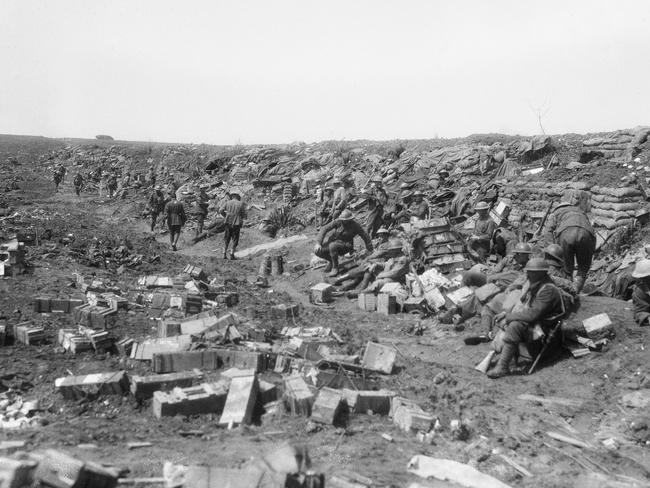How lost ANZAC heroes were finally found
THEY fought together, died together and for almost 100 years their bodies lay hidden together. Now, two Australian soldiers will get the funeral they deserve.
ANZAC Centenary
Don't miss out on the headlines from ANZAC Centenary. Followed categories will be added to My News.
THEY fought together, died together, and for almost 100 years their bodies lay hidden together, two Australian soldiers of the Great War seemingly lost forever.
But on November 12, Private Hedley Roy MacBeth and Lance Corporal James Leonard Rolls will finally get the funeral they deserve, when they are buried side-by-side with full military honours at a service in France.
The young men were killed in action at Bullecourt on May 3, 1917, when an artillery shell exploded on the dugout they were sheltering in by a railway embankment.
They were listed as killed in action and their bodies lost, two more unknown soldiers in a war that claimed 60,000 young Australian lives.
Then, on May 23, 2015, a member of the public found them, near the now-abandoned railway embankment.

In 2017, DNA tests confirmed they were Private MacBeth, from Tasmania and Lance Corporal Rolls, from Melbourne, who were serving together in the 24th Infantry Battalion.
Now, 101 years later, they will be interred at a Commonwealth War Graves cemetery near the village of Buissy on the old front line, in front of Governor-General Sir Peter Cosgrove and family members who have made the journey from Australia to France to pay their final respects.
Lance Corporal Rolls’ grand-niece, Irene Darby, of Canberra, said the extended family had never forgotten him, and honoured him every year on Anzac Day and Remembrance Day.
Born in Prahran in Melbourne, he had been married to Emily Brown and had a little girl, Laura, when he enlisted and went away to fight.
He had been injured but survived in 1916 and went back to the front line, before being killed in May 1917.

Ms Darby said she had been contacted by Paul Vercoe, from the Unrecovered War Casualties Army Unit in Canberra, who told her they were looking for a possible DNA match for Lance Corporal Rolls.
“James’ body was not recovered and buried at that time and he was listed on the Remembrance Roll at Villers-Bretonneux War Cemetery,’’ she said.
Ms Darby’s grandmother on her mother’s side was Ida, older sister to James Rolls, and Ms Darby and a male cousin in Perth provided DNA samples to investigators seeking to identify the two bodies found together in the old railway embankment.
“He was identified by the (unrecovered casualties unit) through a long and protracted process of going through field diaries of battles held in the area where the bodies were found, and identifying those soldiers that remained missing,’’ Ms Darby said.
“This process eventually identified about eight ‘possible’ soldiers and then they researched their family histories and contacted relatives seeking agreement for them to undergo DNA testing.’’

Ms Darby said she was “very happy indeed that he had finally been found – long after those who knew him personally has passed on – this brings closure to the Rolls family.’’
The family has an extensive record of war service and seven family members will be in France for Lance Corporal Rolls’ funeral.
“The funeral for me will be an opportunity to be present when my uncle is finally laid to rest with his comrades in a war cemetery in France with full military honours,’’ Ms Darby said.
“It will give me a time to remember all servicemen who remain missing.
“It will also provide me with an opportunity to thank everyone, both French and Australian, who played a part in this process.’’
Private MacBeth of Launceston in Tasmania enlisted in 1916, leaving behind a wife, Bessie and two children - daughter Mary, 9, and Robert, 5.
One of his grand-nieces, Barbara Reid, of Mentone in Melbourne, said it was hard to imagine the impact World War 1 had on ordinarily families at the time.
“Four of Hedley’s first cousins died at Gallipoli or in France. Hedley’s brother Tasman was wounded at Gallipoli on 29 May 1915 and returned to Australia in January 1916. His brother- in-law, Joseph Quincey returned home with injuries. They had all left behind wives and children when they left for the front,’’ she said, in a written tribute provided to the Australian Defence Force.
She said Joseph Quincey had made inquiries after Private MacBeth went missing in action.
He made a statement at the time to the Red Cross saying: “I was told by Corporal Traske (24th Battalion) that he was with Hedley and others in the dug-out on the railway embankment at Bullecourt when he saw a shell land clean on the dug-out. Two were rescued but died, and the others were unrecognisable and were just buried”.
Joseph’s Quincey was Ms Reid’s grandfather, and her grandmother Hebe was Private MacBeth’s sister.
“My Grandfather often talked to me of the ‘Devastating War’ and the toll it took on our family,’’ she said.
